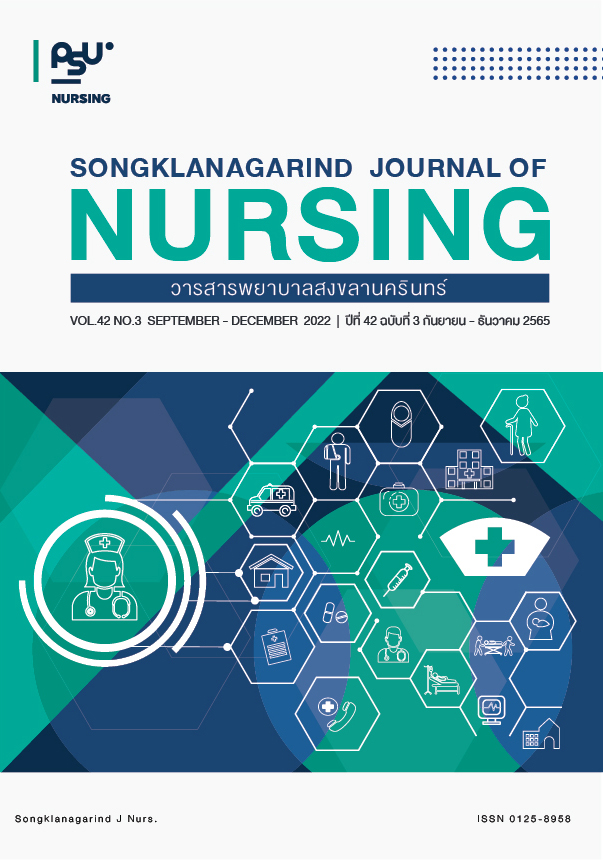Comparison of Quality of Life and Adequacy of Dialysis in Chronic Hemodialysis Patients Between Pre-and Post-Covid-19 Pandemic in Songklanagarind Hospital
Main Article Content
Abstract
Objectives: The purpose of this study was to compare the quality of life of patients with Endstage kidney disease (ESRD) undergoing routine hemodialysis during the pre-and post-epidemic period of COVID-19. Methods: This was a retrospective cohort study collecting data through electronic medical records of ESRD who undergo dialysis at the Kidney Replacement Therapy Center, Songklanagarind Hospital, Hat Yai, Thailand. Patients must undergo hemodialysis for at least three years and receive a 9-THAI quality of life score assessment in the pre-COVID-19 pandemic in 2019 to the post-COVID-19 pandemic during the year 2021. The record form divided into general data collection, information on the adequacy of hemodialysis
and information on quality of life of physical and mental health. Score were analyzed using statistical non parametric Wilcoxon signed-rank test due to non-normally distributed data. Results: The median physical health quality of life scores in the pre-COVID-19 era compared with the post-COVID-19 era were not significantly different (p = .197) for the values. The median mental health quality of life scores in the pre-COVID-19 era were not different from the post-COVID-19 era (p = .187). In addition, adequacy of dialysis (Kt/V) was not different between before and after COVID-19. Conclusion: The quality of life for physical and mental health was not different in the pre-and post-COVID-19 pandemic. Patient care and health promotion are important things that should be practiced continuously both before and after the COVID-19 epidemic.
Article Details

This work is licensed under a Creative Commons Attribution-NonCommercial-NoDerivatives 4.0 International License.
References
Mittal SK, Ahern L, Flaster E, et al. Fishbane S. Selfassessed physical and mental function of haemodialysis patients. Nephrol Dial Transplant. 2001; 16(7): 1387-94. doi: 10.1093/ndt/16.7.1387.
Ngaoratsamee J, Sroisong S. Nursing care for end stage renal disease patients with continuous ambulatory peritoneal dialysis. J Nurs. Health Sci. 2021; 15(1): 28-41. Thai.
Ong-ajyooth L, Vareesangthip K, Khonputsa P, et al. Prevalence of chronic kidney disease in Thai adults: A national health survey. BMC Nephrol. 2009; 10: 1-6. Thai.
The Nephrology Society of Thailand. Handbook of dialysis treatment and plasma filtration for kidney disease patients-2018 [Internet]. [cited 2022 Apr 7]. Available from: https://www.nephrothai.org/wp-content/uploads/2021/10
The Nephrology Society of Thailand. Thailand renal replacement therapy year 2016-2019 [Internet]. 2020 [cited 2021 Jul 8]. Available from: https://www.nephrothai.org/wp-content/uploads/2021/01/1.TRT-Annual-report-2016-2019.pdf
Cheawchanwattana A, Chanlertrith D. Predictive criterion validity of a health-related quality of life 9-Thai by predicting survival rates in dialysis patients. J Nurs Health Care. 2012; 30(2): 23-31. Thai.
Pholdee T, Anuwatnonthakate A. Quality of life among hemodialysis patients at community hospitals in ChiangRai. CMJ. 2016; 8: 19-20. Thai.
Sriyuktasuth A, Vongsirimas N, Praha N. Quality of life and related factors in women receiving hemodialysis and continuous ambulatory peritoneal dialysis: A comparative study. J Nurs Sci. 2017; 35(1): 72-84. Thai.
Yishunkaew R, Na Nongkhai S, Chayakul C. Quality of life of end-stage renal failure patients undergoing hemodialysis according to the rights prescribed by law, a case study of a private hospital. Vajira Nurs J. 2016; 18(1): 79-88. Thai.
Hsu CM, Weiner DE, Aweh G, et al. COVID-19 among US dialysis patients: Risk factors and outcomes from a national dialysis provider. Am J Kidney Dis. 2021; 77(5): 748-56.e1. doi: 10.1053/j.ajkd.2021.01.003.
World Health Organization. Advice for the public on COVID-19-World Health Organization [Internet]. 2022 [cited 2022 Apr 9]. Available from: https://www.who.int/emergencies/diseases/novel-coronavirus-2019/advicefor-public
Sultan BO, Fouad AM, Zaki HM. Adherence to hemodialysis and medical regimens among patients with end-stage renal disease during COVID-19 pandemic: A cross-sectional study. BMC Nephrol. 2022; 23(1): 138. doi: 10.1186/s12882-022-02756-0
Algamdi MM. Assessment of post-COVID-19 quality of life using the quality of life index. patient prefer adherence. 2021; 19(15): 2587-96. doi: 10.2147/PPA.S340868.
Krejcie RV, Morgan DW. Determining sample size for research activities. Educ Psychol Meas. 1970; 30: 607-10.
Petkham M, Petkham L, Intolo S. Comparative study of quality of life between end stages renal disease patients treated with continuous ambulatory peritoneal dialysis and hemodialysis at Sawangdaendin Crown Prince Hospital. J Nurs Healthc. 2020; 38(1): 137-46. Thai.
Darsini D, Notobroto HB, Afiyah RK, et al. Quality of life of hemodialysis patients during COVID-19 pandemic in Gatoel Hospital, Mojokerto City. J Med Sci. 2022; 10: 293-302. doi: https://doi.org/10.3889/oamjms.2022.7583.
Nogueira GM, Oliveira MS, Moura AF, et al. COVID-19 in dialysis units: A comprehensive review. World J Virol. 2021; 10(5): 264-74. doi: 10.5501/wjv.v10.i5.264.
Yun Tang BS, Yi Li P, Yi Xin BS, et al. Prevention and management of COVID-19 in hemodialysis centers. J Manag Care. 2020; 26: 237-8. doi: https://doi.org/10.37765/ajmc.2020.43887.
Kim EY, Lee Y-N, Chang SO. How do patients on hemodialysis perceive and overcome hemodialysis?: Concept development of the resilience of patients on hemodialysis. Nephrol Nurs J. 2019; 46(5): 521-30.
van Sandwijk MS, Al Arashi D, van de Hare FM, et al. Fatigue, anxiety, depression and quality of life in kidney transplant recipients, haemodialysis patients, patients with a haematological malignancy and healthy controls. Nephrol Dial Transplant. 2019; 34(5): 833-8. doi: 10.1093/ndt/gfy103.
Connor KM, Davidson JRT. Development of a new resilience scale: The connor-davidson resilience scale (CD-RISC). Depress Anxiety. 2003; 18(2): 76-82. doi: 10.1002/da.10113.
Kukihara H, Yamawaki N, Ando M, et al. The mediating effect of resilience between family functioning and mental well-being in hemodialysis patients in Japan: A crosssectional design. Health Qual Life Outcomes. 2020; 18(1): 233. doi: 10.1186/s12955-020-01486-x.
Bonenkamp AA, Druiventak TA, van Eck van der Sluijs A, et al. The Impact of COVID-19 on the mental health of dialysis patients. J Nephrol. 2021; 34(2): 337-44. doi: 10.1007/s40620-021-01005-1.
Sousa H, Ribeiro O, Costa E, et al. Being on hemodialysis during the COVID-19 outbreak: A mixed-methods’ study exploring the impacts on dialysis adequacy, analytical data, and patients’ experiences. Semin Dial. 2021; 34(1): 66-76. doi: 10.1111/sdi.12914.
Poveda V, Amado L, Filgueiras M, et al. End-stage renal disease adherence questionnaire: Translation and validation to the portuguese language. Ren Fail. 2016; 38(10): 1633-8. doi: 10.1080/0886022X.2016.1209063.


